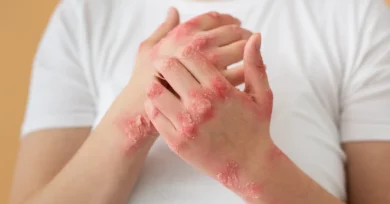Living in the digital era, health has become a priority, whether mental or physical. When talking about physical health, it should be prioritized as checking on body functions will ensure we live a more healthy life. In this article, we will be talking about the autoimmune rash and the autoimmune skin rash in brief. So, keep reading the article to know more about the condition.
What is Autoimmune Rash?
If you have encountered this term for the first time, then let me tell you that autoimmune disease primarily occurs in your body’s immune system. It happens by attacking the healthy blood cells. This causes the immune system to dysfunction, and the response will lead to various symptoms. This includes skin rash, hair fall along joint pain.
It is found that about 50 million Americans are affected with autoimmune rash and its related diseases. This includes rheumatoid arthritis or Hashimoto’s thyroiditis. Studies have also shown that about 5-8% of Americans are prone to experiencing an autoimmune rash disease at some point in their lives. Women are particularly prone to being affected because of their genetic makeup. If you have a family member or a friend or you yourself are suffering from an autoimmune rash, then it’s time to visit the doctor. Head to the section of the article to explore more about the disorder.
Autoimmune Rash Conditions:
In this section of the article, we will be listing out some of the conditions caused by autoimmune disorders that lead to the appearance of rashes on your skin. Have a look at them:
- Psoriasis
- Eczema
- Hypothyroidism & myxedema
- Celiac disease
- Scleroderma
- Lichen planus
- Behçet’s disease
- Lupus
- Sjogren’s syndrome
- Dermatomyositis
Now that you have got a fair understanding of autoimmune rashes, in the next section of the article, we will be discussing why autoimmune rash occur on your skin. Head to the next section to explore more.
Reasons for Autoimmune Rash:
It is often seen that autoimmune disorders cause a rash as they trigger inflammation in the skin cells. These diseases feature chronic inflammation, which occurs in your internal organs, such as the skin, and everywhere in between. When we talk about the autoimmune rash lasting period, the period varies based on the type of the rash and the autoimmune disease that is responsible for it. Some autoimmune rash vanishes away in a few days, while others take a long time to go away.
You must know that you suffer from autoimmune disease when rashes appear on your body, and they look like scaly red patches, and purplish bumps, among others. When we talk about the appearance of these rashes, it varies depending on the autoimmune disease responsible for triggering skin rash.
You can consider the example of cutaneous lupus; it causes a scaly red patch, which does not cause any itching or hurt. When you look at Scalp psoriasis, it may cause a buildup of plaque, which will lead to hair loss. Lichen Planus also is a type of autoimmune rash that causes itchy, purple, flat bumps on your skin, and they are not red in appearance. Hence, the appearance of the different autoimmune rash varied depending on the type of autoimmune disease.
Common Autoimmune Rash:
In this section of the article, we will be listing out some of the common autoimmune rashes that you can consider knowing about. Some of the common autoimmune rashes are:
Sjögren’s Syndrome:
This is an autoimmune disease that leads to dry mouth and eyes. Women above 40 are mainly prone to be affected by this autoimmune disease. Individuals who have Sjögren’s Syndrome are said to get an autoimmune rash, and as per a study, about 3 million Americans are affected by Sjögren’s Syndrome. Sjögren’s Syndrome causes the following skin problems to develop.
- Appearance of purple-to-red skin rash that does not lighten under pressure
- Blood spots on your legs (AKA purpura) due to blood vessel inflammation (AKA vasculitis)
- Appearance of red, ring-shaped skin lesions around a pale center (AKA annular erythema)
- Dry, rough skin (AKA xerosis)
These are some of the skin problems caused by Sjögren’s Syndrome. You can also check out the early-stage autoimmune disease skin rash pictures in the article, which will help you to have an understanding of the early symptoms of Sjögren’s Syndrome.
Folks, let me tell you that sjögren’s syndrome skin rash is not a life-threatening disorder but can reduce the quality of life you lead. As this autoimmune disorder causes dry mouth, you might develop gum diseases and cavities. Such conditions can reduce the quality of your life to a significant level.
Lupus:
This is another common autoimmune rash condition that can be seen in people. Studies have shown that people who suffer from lupus, about two-thirds of the population, will develop skin conditions. The skin conditions that Lupus causes may include sores, rashes, lesions, or cherry angiomas. They have a bright red appearance, and they will look like a raised patch on the skin. It is reported that around 70% of the people who are suffering from Lupus get their condition worsened when exposed to sunlight or under prolonged exposure to fluorescent light. People suffering from lupus will develop this autoimmune rash, usually in the areas of the body that are exposed to the sun, and these rashes will either appear on the cheeks or nose.
Cutaneous lupus:
This is a very common autoimmune disorder that affects only the skin. This autoimmune disorder has three forms, and they are:
Chronic cutaneous lupus: This is also known as discoid lupus, which is reactive to sunlight along with fluorescent light. They produce small amounts of ultraviolet radiation, which worsens this form of lupus. People who are suffering from this type of lupus will eventually notice color discoloration along with scarring. However, Discoid lupus does not cause itching or any kind of hurt but can cause hair to fall out permanently.
Subacute cutaneous lupus: This form of lupus mostly occurs in the areas of the skin that are exposed to sunlight. However, this form of lupus does not cause any itching or scar. But you must know that the areas that get affected by this form of lupus get scaly and discolored.
Acute cutaneous lupus: This is the most common form of lupus, which causes butterfly rash to appear on your cheeks. However, it does not lead to scarring. The appearance that this autoimmune rash will have is like a sunburn, and the affected area will be reactive to sunlight.
Neonatal lupus: This form of lupus is a very rare condition of lupus which affects the infants. During the time of birth, the infants might develop low blood cell count, skin rash, slow heartbeat, and liver problems. These conditions are symptoms of the development of this rare form of lupus.
Dermatomyositis:
This is a type of autoimmune disorder that affects juveniles and a few thousand of the American population. The symptoms of Dermatomyositis are:
- Appearance of red or purple skin rash on a sun-exposed area
- Deposition of calcium underneath your skin (AKA calcinosis)
- Inflammation around your fingernails
- Trouble swallowing (AKA dysphagia)
- Difficulty in talking
- Fatigue
- Muscle weakness
These are some of the common symptoms of Dermatomyositis. The body parts that are affected by Dermatomyositis are:
- Upper chest
- Elbows
- Knees
- Knuckles
- Eyelids
- Nose
- Cheeks
- Back
Eczema:
This is an autoimmune rash condition that causes itchiness. Children are more at risk of developing this autoimmune disorder than adults, and Eczema is of two types. They are:
Contact dermatitis: This is a type of Eczema that causes an allergic reaction on exposure to chemical irritants. This form of Eczema will lead to scaly patches and fluid-filled blisters.
Atopic dermatitis: This form of Eczema is the most common form. This condition causes skin rashes to appear when the conditions of the skin’s natural defenses are weakened. Many people experience this form of dermatitis and develop conditions like asthma, hay fever, and atopic simultaneously.
The body parts that are most affected by this form of autoimmune disorder are:
- Elbow
- Knees
- Scalp
- The back of the neck
- Hands
- Feet
- Arms
- Legs
Celiac Disease:
This is a form of autoimmune disorder that mostly triggers gastrointestinal problems. It also causes autoimmune rash and studies have shown that almost 1% of Americans suffer from celiac disease. Celiac disease takes place because of excessive inflammation in the gut and may lead to the following symptoms:
- Diarrhea
- Depression
- Skin rash
- Stomach growling
- Bloating
- Constipation
- Anemia
- Fatigue
- Gas
Conclusion:
These are the most common autoimmune rash conditions that we have listed for you in this article. In this article, we have briefly discussed the causes as well as the conditions that lead to autoimmune rash. In brief, we have also curated a list of the most common autoimmune disorders. That’s all, folks. I hope the article helped you in getting all the information you needed.






